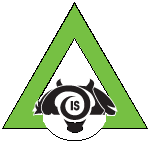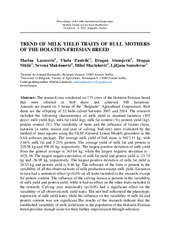Приказ основних података о документу
Trend of milk yield traits of bull mothers of the Holstein-Friesian breed
| dc.creator | Lazarević, Marina | |
| dc.creator | Pantelić, Vlada | |
| dc.creator | Stanojević, Dragan | |
| dc.creator | Nikšić, Dragan | |
| dc.creator | Maksimović, Nevena | |
| dc.creator | Marinkovic, Milos | |
| dc.creator | Samolovac, Ljiljana | |
| dc.date.accessioned | 2023-10-13T08:49:10Z | |
| dc.date.available | 2023-10-13T08:49:10Z | |
| dc.date.issued | 2023-10 | |
| dc.identifier.isbn | 978-86-82431-80-0 | |
| dc.identifier.uri | http://r.istocar.bg.ac.rs/handle/123456789/907 | |
| dc.description.abstract | The research was conducted on 175 cows of the Holstein-Friesian breed that were selected as bull dams and achieved 400 lactations. Animals are reared on 5 farms of the "Belgrade" Agricultural Corporation. Bull dams are the offspring of 32 bulls calved between 2007 and 2014. The research included the following characteristics of milk yield in standard lactation (305 days): milk yield (kg), milk fat yield (kg), milk fat content (%), protein yield (kg), protein content (%). The variability of traits and the influence of factors (farm, lactation in order, season and year of calving, bull-sire) were evaluated by the method of least squares using the GLM (General Linear Model) procedure in the SAS software package. The average milk yield of bull dams is 9617.11 kg, with 3.44% milk fat and 3.21% protein. The average yield of milk fat and protein is 329.56 kg and 308.65 kg, respectively. The largest positive deviation of milk yield from the general average is 363.64 kg, while the largest negative deviation is - 1021.36. The largest negative deviation of milk fat yield and protein yield is -21.74 kg and -36.09 kg, respectively. The largest positive deviation of milk fat yield is 18.35 kg and protein yield is 9.46 kg. The influence of the farm is present in the variability of all the observed traits of milk production except milk yield. Lactation in turn had a statistical effect (p<0.05) on all traits included in the research, except for protein content. The influence of the calving season is present in the variability of milk yield and protein yield, while it had no effect on the other traits included in the research. Calving year statistically (p<0.05) had a significant effect on the variability of all observed milk yield traits. The sire bull influenced the phenotypic expression of milk yield traits, while his influence on the variability of milk fat and protein content was not significant.The results of the research indicate that the established variability of milk yield traits in the population of the Holstein-Friesian breed provides enough room for their further improvement through selection. | sr |
| dc.language.iso | en | sr |
| dc.relation | info:eu-repo/grantAgreement/MESTD/inst-2020/200022/RS// | sr |
| dc.rights | openAccess | sr |
| dc.rights.uri | https://creativecommons.org/licenses/by/4.0/ | |
| dc.source | Proceedings of the 14th International Symposium Modern Trends in Livestock Production | sr |
| dc.subject | bull dams, milk traits, variability, genetic trend, Holstein-Frisian breed | sr |
| dc.title | Trend of milk yield traits of bull mothers of the Holstein-Friesian breed | sr |
| dc.type | article | sr |
| dc.rights.license | BY | sr |
| dc.citation.spage | 408 | |
| dc.citation.epage | 417 | |
| dc.identifier.rcub | https://hdl.handle.net/21.15107/rcub_ristocar_907 | |
| dc.identifier.fulltext | http://r.istocar.bg.ac.rs/bitstream/id/4345/bitstream_4345.pdf | |
| dc.type.version | publishedVersion | sr |


